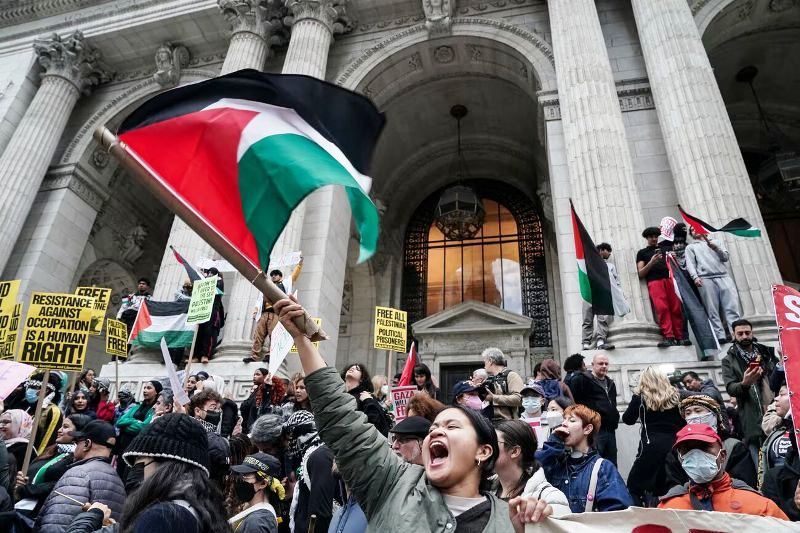
On October 7th, when Hamas attacked Israel, and Gaza faced bombardment, the superintendent of the Los Angeles Unified School District posted on social media, expressing support for Israel. Weeks later, the teachers’ union in Oakland, California, issued a statement condemning the Israeli government, calling it an apartheid state and condemning the 75-year-long military occupation of Palestine.
Both statements received immediate backlash from the community, including parents, teachers, and politicians, who either disagreed with the content or were confused about why a local school district took a stance on a global conflict. This isn’t limited to California; in Massachusetts, two school district superintendents faced criticism for not addressing Hamas sufficiently, and a Minneapolis teachers union caused controversy by calling for aid to Gaza and boycotting Israel.
Throughout the US, public schools taking positions in the war often lead to more division than solidarity, putting districts in hot water over their approaches. Some statements lacked context or were issued prematurely, resulting in retractions. This backlash is part of a nationwide politicization of the education sector, especially in K-12 public school districts, where school boards have become battlegrounds for culture wars.
Schools have become conflict zones in recent years, making education politics more partisan. The issues in K-12 schools reflect broader societal divisions over the Israel-Hamas war, seen on college campuses, in workplaces, and in government. Experts point to dynamics in public schools, where right-wing extremist organizations like Moms for Liberty launch “conflict campaigns” to bring partisan debates into schools, aiming to sow distrust in public institutions. Typically, these groups focus on targeting lessons related to racism or LGBTQ+ issues and advocate for banning certain books. Experts suggest that these efforts are primarily concentrated in politically divided areas, often identified as purple and blue districts, including regions around Los Angeles and the San Francisco Bay Area.
While these groups may not be directly contributing to tensions in schools concerning the Israel-Gaza conflict, John Rogers notes that their unconventional methods have made the expression of political grievances in education more commonplace.
Another contributing factor is the closure of schools during the pandemic, implemented swiftly to curb the spread of Covid. Jon Valant, a senior fellow at the Brookings Institute and director of its Brown Center for Education Policy, points out that discontent with the reopening pace and mask mandates led to a surge in parents and community members attending school board meetings to voice their concerns. This mobilization extended beyond pandemic-related issues.
From the aftermath of the 2020 George Floyd murder to the adoption of Diversity, Equity, and Inclusion (DEI) efforts, schools have become focal points for various political controversies unlike anything seen before. Valant emphasizes the heightened attention and sensitivity in schools toward political issues.
These factors have made it challenging for schools to facilitate productive discussions on complex issues. Teachers and administrators find themselves on the defensive, prompting some administrators to view official statements as a preemptive measure against pressure from parents or the community.
With educators facing accusations of teaching “critical race theory” or promoting a “woke” agenda in support of transgender students, teachers are increasingly hesitant to introduce contentious topics into their curriculum.
Many fear potential repercussions on their careers, contributing to teachers’ reluctance to engage in such discussions. Andrene Castro, an assistant professor of educational leadership at Virginia Commonwealth University, highlights the prevailing concern among educators about the risk of being reported.
In Alameda County, a Palestinian-American teacher is worried that if she assigns readings from Palestinian authors to her students, there could be negative consequences.
Our US morning briefing summarizes the important stories of the day, explaining what’s happening and why it matters. However, expressing concerns about an incident where most people agree, like a mass shooting, is straightforward. Yet, according to Rogers, taking a clear stance on a controversial global conflict can stir people up, especially in districts with diverse student populations. He mentions that statements are ineffective in communities with varying values or interests.
In Oakland, school district officials are in a challenging situation with teachers advocating for a teach-in focused on Palestinian history. When schools or local governments mishandle statements and need to retract them, it often creates new problems. Rogers emphasizes the need for a complex and nuanced understanding to contextualize issues educators may lack.
Ailen Arreaza, the executive director of the national education advocacy organization Parents Together, notes a common concern among parents: student safety. Following the events of October 7th, she heard from parents worried about the targeting of Jewish and Muslim students. Arreaza emphasizes that these parents prioritize practical resources about tolerance and bullying over assertive political statements – they want their kids to be safe.
Education experts are worried that the turmoil outside the classroom is diverting resources away from fostering crucial conversations about Israel and Palestine within the schools. Ignoring these issues can make students disengaged, as seen in 2012 when Trayvon Martin, a 17-year-old Black boy, was killed in Florida.
Andrene Castro, who was teaching high school at the time, explains that teachers avoided discussing the event, leading Black and brown students to grapple with intense emotions and struggle to connect with the curriculum. Castro emphasizes the critical role of educators in helping students and communities understand these issues collectively. Students want to make connections, and teachers play a vital role in facilitating that understanding.

